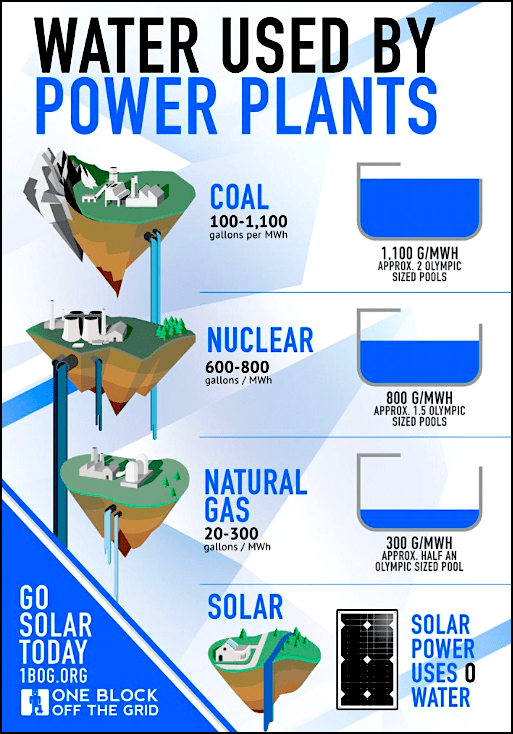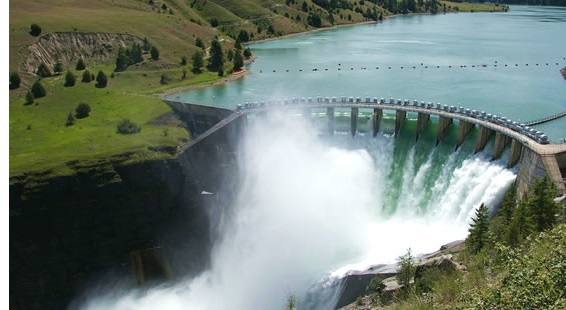Water for Energy for Water
Water and energy are inextricably linked.
It takes a significant amount of water to create energy. Likewise, it takes a significant amount of energy to extract, move and treat water.
U.S. power plants withdraw 143 billion gallons of fresh water every day. That’s more than the amount withdrawn for irrigation and three times as much as is used for public water supplies.
Water and Electricity
When we think of water and electricity, hydropower is usually the first thing that comes to mind. But power plants that use coal, oil, nuclear energy or natural gas are also water-dependent.

By burning coal or natural gas (or by maintaining a fission reaction), these power plants generate heat. The heat is then used to boil water, produce steam, and turn turbines. Much of the water used by these plants is needed to cool the steam they generate.
Withdrawal vs. Consumption
In order to better understand how much water is used by power plants, we must first define some terms.
 Water “use” by power plants comes in two forms: withdrawal and consumption. Withdrawal refers to the amount of water a power plant extracts from a lake, river, aquifer, or other water source. Power plants that use “once-through cooling” technology withdraw large volumes of water a single time. They then discharge it directly to waste.
Water “use” by power plants comes in two forms: withdrawal and consumption. Withdrawal refers to the amount of water a power plant extracts from a lake, river, aquifer, or other water source. Power plants that use “once-through cooling” technology withdraw large volumes of water a single time. They then discharge it directly to waste.
Withdrawal is important for several reasons:
- Water intake systems can trap aquatic wildlife
- Water withdrawn for cooling (but not consumed) is returned to the environment heated, potentially harming wildlife
- Power plants that tap groundwater for cooling can deplete aquifers.
Consumption refers to the water that evaporates in the cooling process. Consumption reduces the amount of water available for other uses, such as sustaining ecosystems. Plants that use “recirculating cooling” technology tend to have lower rates of water withdrawal, but consume much more of that water through evaporation.
So How Much Water Do Power Plants Use?
A 2013 report published in Environmental Research Letters found that, in the year analyzed (2008), U.S. power plants:
- Withdrew some 50 trillion gallons of water
- Consumed 1.6 trillion gallons of that water
- Used freshwater (non-ocean) sources for 86 percent of those water withdrawals and 96 percent of the water they consumed.
This means that about 100 billion gallons of freshwater is withdrawn daily and several billion gallons consumed.

How does this compare with our other water needs, say, agriculture?
When it comes to withdrawals, power plants are number one. According to the most recent available data provided by U.S. Geological Survey, the power sector is responsible for more than 40 percent of freshwater withdrawals.
On the consumption side, agriculture is the biggest user. (Much of the water used to irrigate fields doesn’t make it back out.)
What Can Be Done?
As climate change continues to affect precipitation and temperature patterns across the country, water-dependent energy production could be inhibited.
 There are several ways we can address the water-related impacts of energy use:
There are several ways we can address the water-related impacts of energy use:
- Designing appliances, buildings, and vehicles to be more energy efficient. This is the simplest and most cost-effective solution. The less energy used, the less water required.
- Retrofitting old coal or nuclear power plants with more water-efficient cooling systems. According to scientists, this could potentially double water consumption, but could reduce water withdrawals to a mere fraction of current use.
- Encouraging (i.e., incentivizing) the expansion of renewable technologies (such as wind and solar energy) that require no water usage.
Sources:
Union of Concerned Scientists
National Conference of State Legislatures
U.S. Dept of Energy






